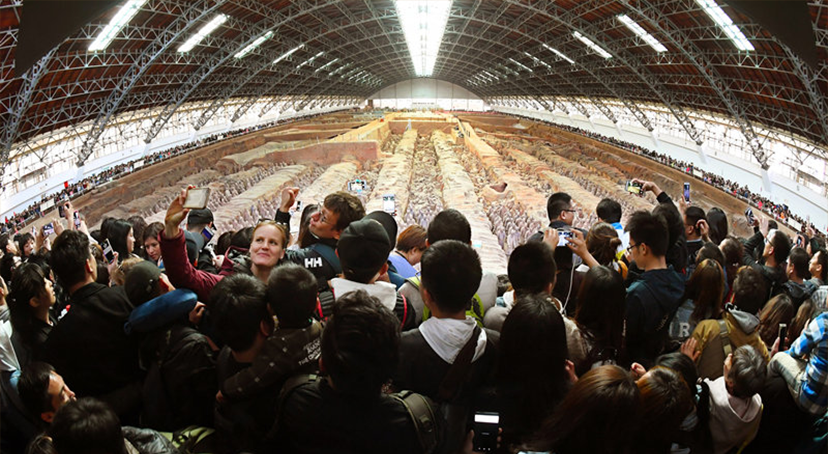News
M0RE 
Announcement
M0RE 
History of Qin Shihuang Museum
- Shaanxi Provincial Cultural Bureau - the Terracotta Army Mus
- Shaanxi Provincial Cultural Bureau - the Terracotta Army Mus
- Qin Shihuang Terracotta Army Museum opened and opened
- Shaanxi Provincial Cultural Bureau - the Terracotta Army Mus
Events
-
In March 1974, Emperor Qin Shihuang's Terracotta Army was discovered. MAR / 1974
MAR / 1974
-
In August 1975, the State Council decided to establish a museum at the site where Emperor Qin Shihuang's Terracotta Army was discovered. AUG / 1975
AUG / 1975
-
On October Ist, 1979, Emperor Qin Shihuang's Terracotta Army Museum was opened to the public. 01 /OCT / 1979
01 /OCT / 1979
-
On December 11th, 1987, UNESCO added Emperor Qin Shihuang’s Mausoleum(including the Terracotta Army pits)to the World Heritage List. 11 /DEC / 1987
11 /DEC / 1987
-
On September 27th, 1989, the exhibition hall of pit No.3 of Emperor Qin Shihuang’s Terracotta Army was opened to the public. 01 /SEP / 1989
01 /SEP / 1989
-
On October Ist, 1994, the exhibition hall of pit No. 2 of Emperor Qin Shihuang's Terracotta Amy was opened to the public. 01 /OCT / 1994
01 /OCT / 1994
-
On October Ist, 1999, the exhibition hall of artifacts unearthed from Emperor QinShihuang's Mausoleum was opened to the public. 01 /OCT / 1999
01 /OCT / 1999
-
In 2007, Emperor Qin Shihuang's Terracotta Army Museum was named as one of the first national 5A-class tourist attractions. 2007
2007
-
In 2008, Emperor Qin Shihuang's Terracotta Army Museum was named as one of the national first-tier museums. 2008
2008
-
In 2009, Emperor Qin Shihuang's Terracotta Army Museum received a group qualification certificates for independently conducting archaeological excavations. 2009
2009
-
In 2009, Emperor Qin Shihuang's Mausoleum Site Museum was established. 2009
2009
-
On Oct 1st, 2010, Emperor Qin Shihuang's Mausoleum Site Park, one of the first national archaeological parks, was opened to the public. 01 /OCT / 2010
01 /OCT / 2010
-
On Sep. 30th, 2011, the exhibition halls of sacrificial pits K9901 and Ko006 was opened to the public. 30 /SEP / 2011
30 /SEP / 2011
-
On Dec. 27th, 2013, "Emperor Qi Shihuang’s Mausoleum was selected as one of China's new archaeological discoveries in 2013" by the Archaeological Forum of the Chinese Academy of Social Science. 27 /DEC / 2013
27 /DEC / 2013
 Introduction of the Museum
Introduction of the Museum

Emperor Qinshihuang's Mausoleum Site Museum(Terra-cotta Warriors Museum) is one that is specialized in relic display. The main object exhibited here are the terra-cotta figures of more than 2000 years old. These figures stand for the garrison force that protects Emperor Qinshihuang's mausoleum.
It is already known that the mausoleum consists of two sections, an inner city and an out city, both rectangular in shape. The tomb lies in the southern part of the inner city. Originally, the tomb was 115m high. After over 2000 years weathering, the mausoleum today still remains more than 70m in height. Approximately 500 satellite tombs and pits have been discovered in the vicinity of the mausoleum.
The burial pits of the Terra-cotta Warriors and horses are located about 1.5km east of Emperor Qinshihuang's Mausoleum. In march 1974, local farmers discovered broken pieces of Terra-cotta figures when digging a well. After a year of investigation and excavation, the archaeological team unearthed a large pit , in which approximately 6000 Terra-cotta Warriors and horses were discovered. Following this discovery, in the summer of 1976, they found two other pits. According to the sequence of the discoveries, those pits were named Pit 1, Pit 2 and pit 3 respectively. The Terra-cotta Warriors and horses are all life-sized, and the warriors carry real bronze battle weapons. Orderly arrayed in rows and lines, these figures of warriors and horses make up a great underground army consisting of war chariots, infantrymen, cavalrymen and other armed servicemen. This amazing discovery caused an immediate stir among Chinese archaeologists and soon attracted the attention of the world. People called this find "one of the world wonders" and "one of the greatest archaeological discoveries of the twentieth century.
Covering an area of 56.25sq.km, it took 37 years and around 720,000 labors to build Emperor's mausoleum, standing as the grandest with the richest burial objects among all the imperial tombs throughout Chinese history. It mainly consists of subterranean palace, city walls and gates, various burial objects, burial pits, and all kinds of affiliated architectures. The whole mausoleum was well designed and rich in burial objects. The layout of tomb and arrangement for the ritual facilities, both traditional and innovative, has a far-reaching impact on the imperial mausoleums of subsequent dynasties.
At present, there are already 149 burial pits, 196 burial tombs have been discovered, including the Bronze Chariots pit, the Rare Birds pits, the Barns pits in small and large scales, the Stone Armor pit, the Warriors and Horses pits and other sacrificial pits. All those together build a massive treasure house. On March 4th 1961, the State Council declared Emperor Qinshihuang's mausoleum a major historical and culture sites protected at the national level, one of the first sited in the country. The mausoleum including the pits of Terra-cotta Warriors and Horses was listed as one of the UNESCO World Cultural Heritage Site on December 7th 1987.







 A. Male
A. Male